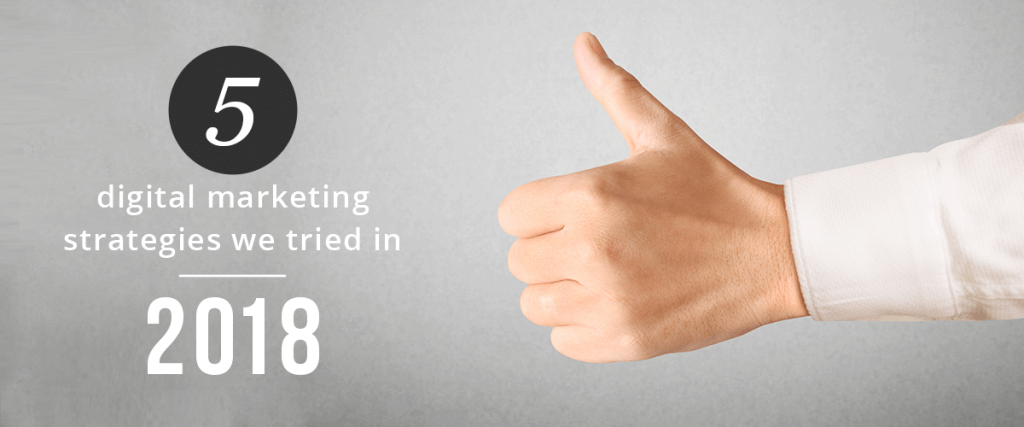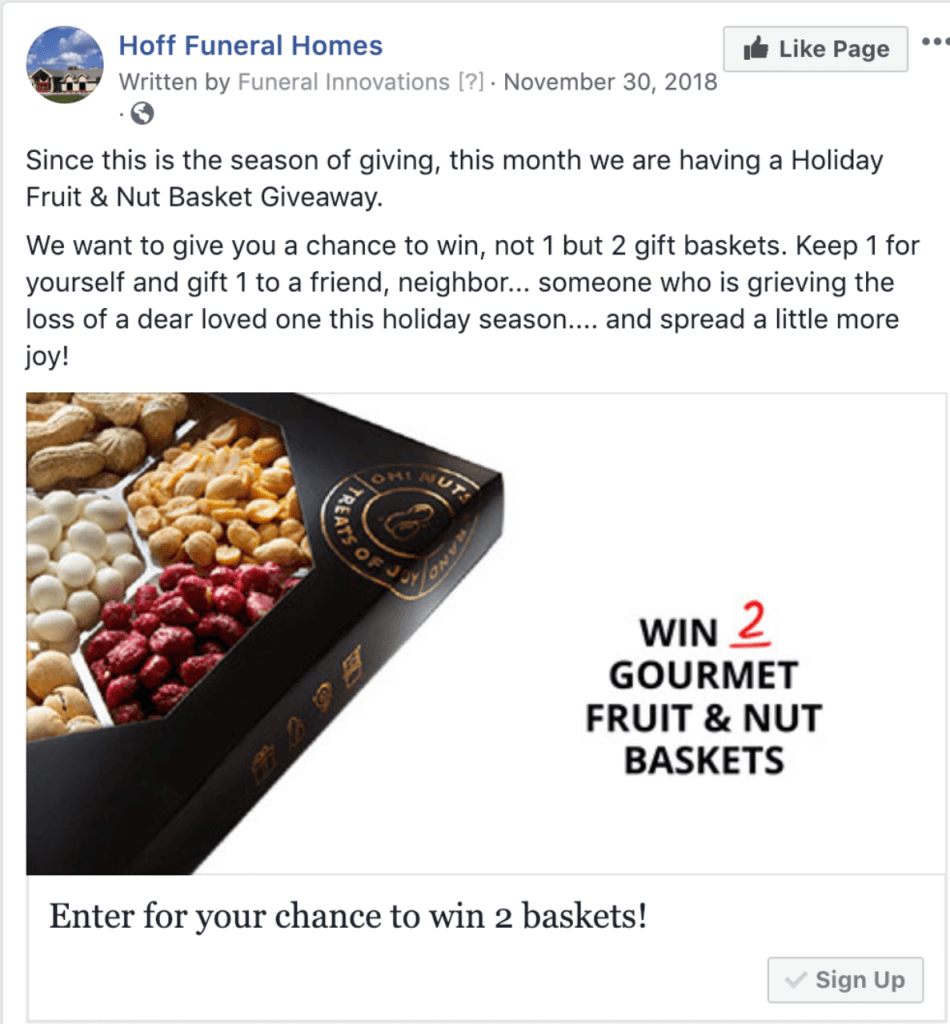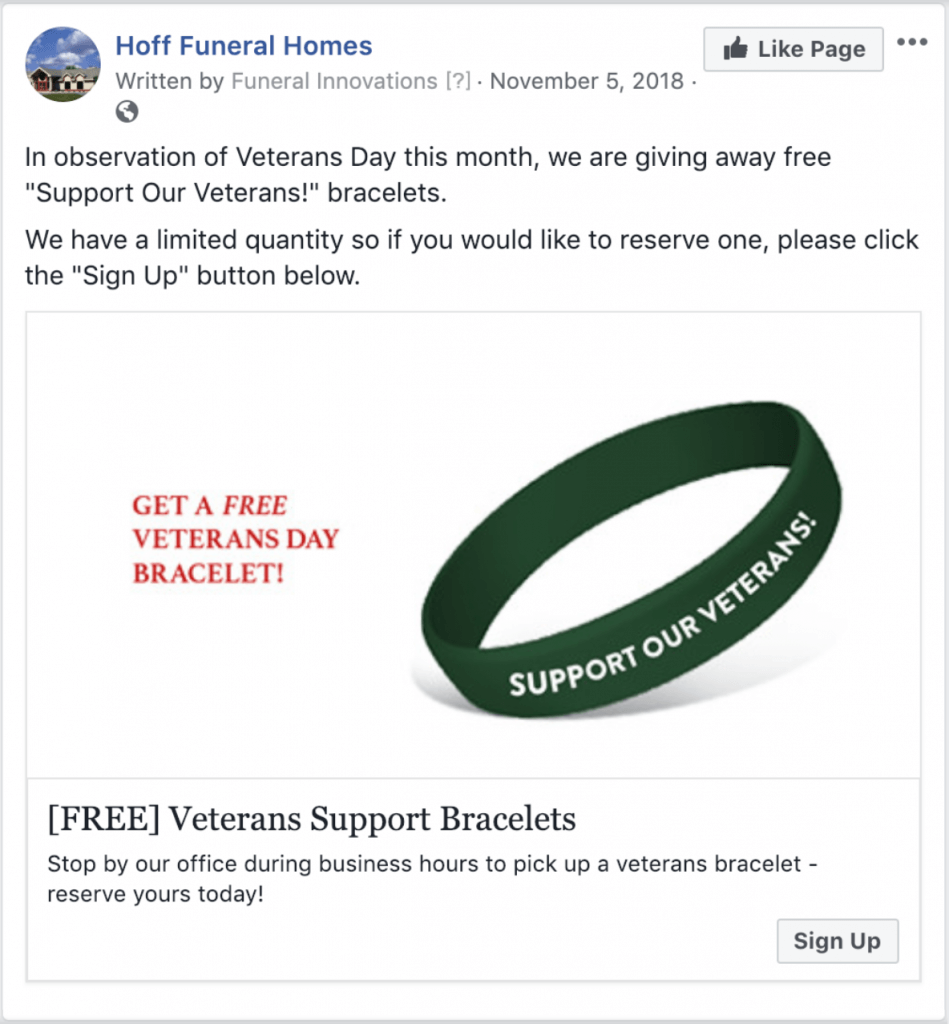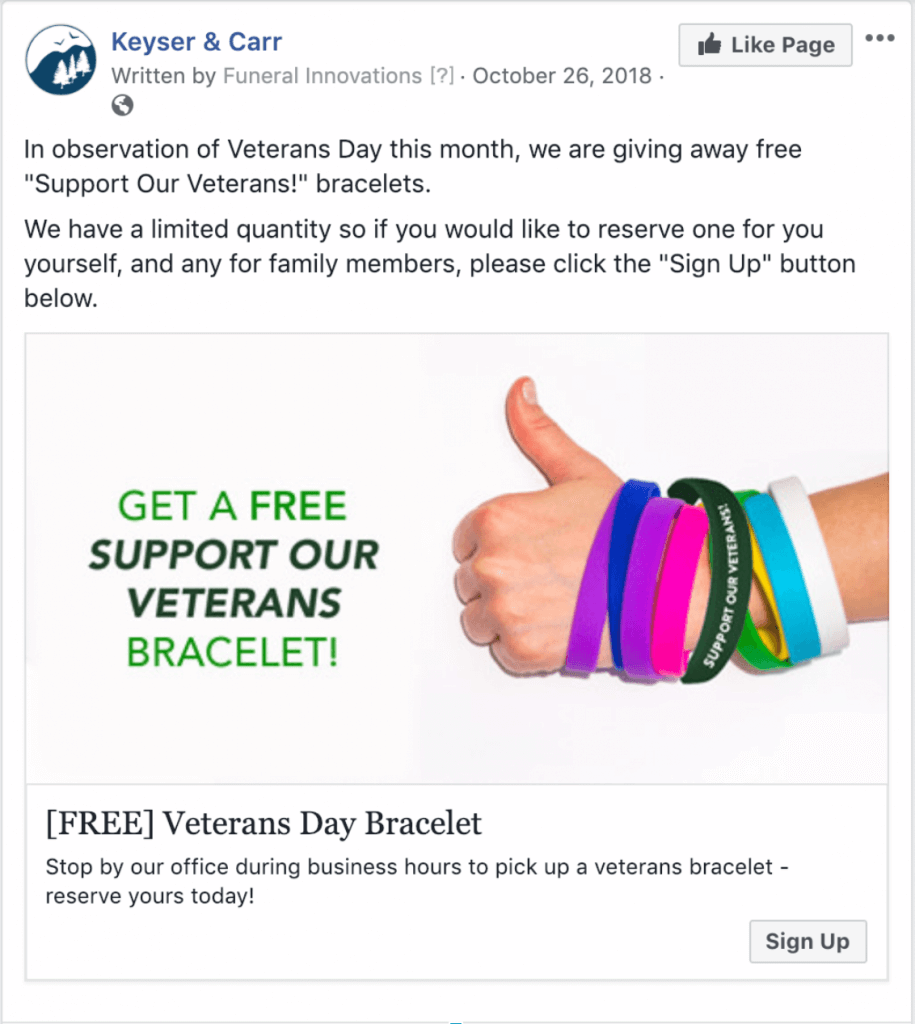A version of this post was originally published in The Funeral Service, a Kates-Boylston Publication.

At Funeral Innovations we like to try new things. In fact, we strive for it. After all, it’s in our name. And for us, that means experimenting with new digital marketing strategies both for our clients and for our own business. That constant innovation helps provide long-term security for our clients and for ourselves.
All our new ideas don’t work out. That’s part of the process. For us, that’s ok. But when you are a busy funeral director dividing your time between running a business and serving your families, a constant process of testing new ideas may not be an option. Too little time, too few resources or even a lack of marketing technology to apply new trends to your firm make experimentation a challenge. So this year we thought we’d pull back the curtain and share some of our most success strategies, experiments and campaigns with you. That way you can cut out the trial-and-error and head straight to the “win.”
The 5 high-performing digital marketing strategies from 2018.
1.Move beyond Facebook to email nurturing
The Why: Facebook’s very bad year
Last year was rough for Facebook. Identity theft, political scandals, fake news, and more put Mark Zuckerberg and the social media company in the (negative) headlines on a regular basis. And while Facebook is still the unquestionable king of social media marketing, we wanted a way to help our clients deliver useful information to their families through another channel.
The Strategy: Nurture contacts collected from Facebook through email
Attracting people on Facebook is essential, but we wanted to move our clients away from using Facebook for ongoing communication. In marketing speak, this is an important business practice called “diversifying your channels” and protects businesses from a “bad Facebook year” overly impacting their own marketing efforts.
To build relationships outside of Facebook, we created a library of nurturing emails and email series that go directly to families interested in specific Facebook campaign topics. How does it work? A firm runs a Facebook ad campaign on a particular subject (think preneed planning, planning a veteran’s funeral, creating a living will, etc.). Community members who sign up through Facebook received a series of emails on the topic directly from the funeral home. This nurtures the relationship using informative content. These emails might be sent over a week, a month or longer. It depends on the topic and what the person signed up for. Delivering informative content over time builds and solidifies a relationship by making a firm the trusted source on the topic, it keeps the firm’s name top of mind for longer and it adds an additional touchpoint other than Facebook. All smart business plays.
The Win(s):
This strategy was a huge success. It:
- Turned Facebook leads into preneed sales
- Generated more interest among community members who signed up for the emails
- Positioned the firm as an expert on the topic in the community
- Supplemented Facebook marketing with a new digital strategy
2. More digital aftercare and grief support
The Why: Losing a loved one is isolating
The need for follow-up care after a death can be deep and profound for many families surviving a loss. And since serving families is the heart of the business, most firms strive for a powerful aftercare strategy. Good aftercare and grief support for loved ones following a death not only helps the family survive the loss, it also builds the relationship between the family and the funeral home or cemetery. However, aftercare is also time consuming for funeral directors, and people’s changing expectations mean survivors want aftercare in new ways.
The Strategy: Email support for grieving families
Last year we added more aftercare email options to our content lineup. How do grieving loved ones get these emails? They can sign up for them directly from our clients’ websites or a funeral director can add the loved ones’ emails to their aftercare email list after a death has occurred. Either way the grief support emails are automatically sent directly to people’s inboxes and it takes our clients almost no extra time.
This strategy proved a huge success. Funeral directors and families universally appreciated the service. Many families appreciated the compassionate, relevant and hope-filled content so much they sent heartfelt thank you emails to the funeral homes. And we received thank yous from our clients, too. Here are some examples:
- “I want to take a minute to thank you for the emails about grieving that you have sent over the last six months. I found them to be very comforting and helped in understanding the feelings and emotions that I was experiencing.” – A grieving loved one
- “We have gotten 3 thank you emails from these today alone,” and, “We usually get a compliment per day for the aftercare series.” – Fred Hunter’s Memorial Services
- “Wish I had a dollar for every one of these – so many people respond.” – Clock Life Story Funeral Home
The Win(s):
For our clients this experiment produced big rewards:
- Built a stronger relationship with families in firms’ communities
- Kept firms top-of-mind after a death
- Helped families get through a loss
- Generated word-of-mouth support for firms in their community
- Created a warm, fuzzy feeling (who doesn’t like “thank you” emails from satisfied people?)
3. Generate business using Facebook…and fast.
The Why: Facebook is essential, but immediate results can be elusive.
Everyone knows Facebook must be part of their digital marketing strategy, but generating business from it on a tight timeline can seem elusive. We set out to solve that puzzle with a company-wide “Innovation Challenge.”
The Strategy: Dream up new Facebook campaigns to generate new business
We set aside a day as a company to work on this dilemma and called it our “Innovation Challenge.” Company staff split into teams and partnered with a funeral home or cemetery client to create Facebook ad campaigns specifically meant to convert leads into new business using a fresh approach.
We crafted Facebook ads, targeted specific audiences and came up with novel tactics — things like unique incentives, gift certificates or a free American Flag display box for veterans — as a new way to grab people’s attention. We then ran the ads for two weeks and collected contact information from interested community members. Those contacts were delivered directly to the funeral homes’ inboxes and flagged as interested preplanners.
Follow-up emails alerted the new contacts that a preplanning counselor would reach out to them. Those calls opened the door to in-person connections that ended in preneed business. Once we nailed campaign approaches that garnered results in a few markets, we expanded them (successfully) to other markets with similar results.
The Win(s)
- Collected 136 contacts through the Innovation Challenge that led to three closed deals
- Opened the door to numerous in-person appointments
- Follow-up campaigns generated more than $40K in closed deals for one firm
- Built rapport with new connections for future business opportunities
4. Giveaways get results
The Why: Make funeral homes a force for good
If building goodwill between your firm and your community isn’t a goal, it should be. While it’s essential that people in your area know your name and understand your services, sometimes doing something kind or even fun is just the thing to drive awareness, engagement and get people singing your praises (or walking through your doors). This type of strategy is a long-term play meant to solidify reputation and increase loyalty for more business down the road. With that in mind, we crafted several giveaway campaigns meant to engage community.
 The Strategy: Give things away!
The Strategy: Give things away!
We ran several “giveaway” paid ad campaigns on Facebook for clients. One option asked for people’s contact information in return for a chance to win TWO gourmet fruit-and-nut gift baskets. The winner kept one basket and gave the second to a family member, friend, local senior center or other charity solely to brighten their day. People LOVED this pay-it-forward strategy and the sense of unity and goodwill the experiment inspired.
The campaign gathered 3,021 sign ups (a.k.a. leads) and many heartfelt comments on Facebook such as, “So many families are grieving this Christmas. This giveaway will bring a boost to two of them – thank you!” and, “It would be so wonderful to give to someone I know who’s really missing their mom.”
The second campaign offered free “Support Our Veterans!” bracelets for anyone interested. To get a bracelet, people filled out their contact information online. An average of 94 contacts signed up per campaign. The people then came to the funeral home to claim their bracelet. Not only did participating firms giveaway hundreds of bracelets, they got people through their doors, making it a perfect opportunity to connect personally. Some firms took the opportunity to hand out preplanning guides with the bracelets, too.
The Win(s)
- Increased interaction with people on Facebook and in person
- Collected thousands of contacts for future nurturing campaigns
- Built goodwill with the community
- Got people talking about funeral homes unrelated to a funeral service
BONUS: NFDA lockbox giveaway
We liked this giveaway strategy so much, we used it for our own marketing. We mailed out hundreds of keys to funeral homes with a card asking them to try their key on our lockbox at the 2018 NFDA conference. We set up the lockbox at our booth and kept it stocked with fun giveaways (Apple Airpods, an Apple Watch, Amazon Echos and more). Over the course of the conference, we had hundreds of people stop by to see if their key unlocked the box. It was a great way to meet new people, and it was super fun to watch folks try (and win!) our giveaways. Stay tuned… there are definitely more keys to come this year!
5. Paid Facebook ads are increasingly important
The Why: New Facebook rules
Changes to Facebook’s algorithm make reaching your audience with organic posts increasingly difficult. In Facebook lingo “organic” means the number of people who find your post without any paid advertising behind it. “Organic” isn’t so much about the content of the post as the way people discover it. Typically, Facebook business pages can only be seen organically by 16% of a page’s followers, according to Facebook. That means if you have 300 followers, or fans, roughly 50 will see your organic post.
The Strategy: The right ads to the right people
The best way to put your content in front of more people (followers and new folks alike) is to run paid ads on Facebook. Paid ads are different than boosted posts (which you can do from a little button at the bottom of your posts). Facebook ads let you add call-to-action buttons, target certain user behavior, collect contact information, direct people to other information like a blog post or website, and more. Facebook ads reach more people than boosting a post, engage more people and focus on driving them to take a particular action.
We found three keys to creating the most effective Facebook ads in 2018: use the right message and imagery, target the right audience, and set your ad budget (the amount of $$ you’ll spend) correctly. Misalignment on any of these will impact your results and collect fewer leads or fewer leads that convert.
While ads are becoming more important, it’s still a good idea to boost some posts. This helps find new followers and usually for less money than an ad campaign, However, if you want new preneed sales, ads really help deliver quality contacts.
Reminder: Paid ads work best if you are posting professional, quality content. And just because you run paid ads or boost posts doesn’t mean you can stop posting regularly (we recommend everyday). While the paid posts reach more people, those people want to see what you are all about when they visit your Facebook page. Demonstrate your knowledge and reliability by having lots of useful, high-performing content on your Facebook page when those new people show up to check you out.
The Win(s)
- Reached 9+ million people with paid posts this year
- Opened doors to thousands in of dollars in new business
- Converted people interested in the ads into new families for firms
- Targeted the right people for better conversion rates
Wrap it up
Trying new things – and staying on top of what works – is key to keeping your firm positioned properly to capture more market share today, tomorrow and years down the road. While innovation and experimentation take time, the results are well worth the effort.



